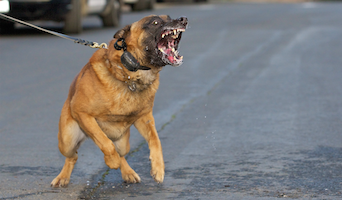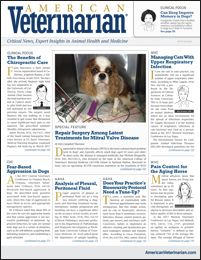CVC Virginia Beach 2017: Fear-Based Aggression in Dogs
Understanding when fear-based aggression is most likely to occur, plus how to identify and manage it.

At the 2017 Central Veterinary Conference in Virginia Beach, Virginia, veterinary behaviorist John Ciribassi, DVM, DACVB, discussed fear-based aggression in dogs. He described body postures associated with fear-based aggression, when this type of aggression is most likely to occur, and appropriate management options.
Dr. Ciribassi noted that about 80% of the cases he sees are aggression based, and that canine aggression is not necessarily problematic or abnormal.
Aggressive behaviors, he said, are normal tools dogs use in a variety of situations, such as for self-defense, acquiring food, defending resources, and establishing a pack structure.
If an owner comes in with an aggressive dog, it’s important to remember that “aggressive behaviors are not pictures, they’re movies,” he advised. Rather than being static, the aggression has progressed over time.
Recognizing Fear In Dogs
To diagnose fear-based aggression, it is important to evaluate the overall history, determine when the aggression occurs, and observe the dog’s body postures during threatening situations. Dr. Ciribassi cautioned against assuming that a fearful dog has a history of being abused.
In a threatening situation, a fearful dog initially will display defensive behaviors, which often go unrecognized because many pet owners are not familiar with canine body language: ears back, tail tucked, head down, piloerection, averted gaze, underbelly exposed, weight shifted backward, lips retracted vertically and teeth exposed, and urinating, defecating, and expressing anal sacs.
If these postures do not ameliorate the situation, the dog will escalate its behavior and become overtly aggressive—often explosively—to manage the threat. “If a subtle technique, like looking away or yawning, doesn’t achieve the desired result,” Dr. Ciribassi said, “then the dog is going to be motivated to try something else.” Therefore, if aggressive behavior manages the threat effectively, the dog will learn to use it more efficiently and as a first resort. “If a dog learns that the use of aggressive behavior in perceived threatening situations is an effective strategy to manage those situations, then the use of aggressive behavior becomes reinforced.”
Dr. Ciribassi also described dominance-based aggression, given that many cases of fear-based aggression are misdiagnosed as dominance-based, leading to aversive-type treatment methods that actually worsen a dog’s fear. “In my opinion,” he said, “most of those cases of aggression are fear-based, so if we use punishment-based techniques we tend to escalate the problem.”
Dominant behavior, characterized by confident body postures and ritualistic displays, usually begins at social maturity and is used to establish a hierarchy. Interestingly, dogs may progress from defensive to dominant body postures if they learn how to use aggression to successfully manage a situation; the defensive postures can return, however, in overwhelmingly threatening situations.
Fear-Inducing Situations
Fear-based aggression commonly occurs during leash walks. The leash can transmit the owner’s anxiety and make it difficult for dogs to display typical aggressive behavior. Fearful dogs on a leash may display aggression as an unfamiliar person or dog is walking away.
Fear can also result from an owner trying to establish dominance over the dog, using strong physical or verbal punishment, or having inconsistent interactions with the dog. In turn, the dog may become fearful and resort to fear-based aggression (BOX).
Managing Fear-Based Aggression
Addressing fear-based aggression in dogs requires a team approach, involving the owner, the veterinarian, and a professional animal behaviorist. The primary management options are removing triggers, redirecting aggressive behavior, and medical management.

Managing triggers may involve separating the dog from the trigger. For example, if strangers trigger fear-based aggression, keep the dog in a separate room when unfamiliar people visit. Another option is response substitution, in which the owner distracts the dog and redirects inappropriate behavior to more appropriate responses that can be reinforced. Pet owners should avoid reinforcing aggressive behavior with positive attention; in other words, don’t tell the dog “it’s OK.”
Redirecting the behavior involves counter conditioning to train the dog to perform behaviors that are counter to the problem behavior. This can be done through operant or classical conditioning. In both scenarios, the dog is asked to perform behaviors it already knows, and these behaviors should be reinforced. A fearful dog should learn to seek its owner’s direction during a threatening situation.
Medical management is indicated for fearful dogs that are overly reactive and do not follow direction or take rewards. This typically involves serotonin pathway reactivation to reduce amygdala-induced reactivity. Dr. Ciribassi recommended the selective serotonin reuptake inhibitors (SSRIs) fluoxetine, paroxetine, and sertraline. He also recommended clonidine and trazodone, both of which can be used situationally and in combination with an SSRI.
Dr. Ciribassi cautioned against managing fear-based aggression with amitriptyline because dogs can quickly build tolerance to it. In addition, benzodiazepines would not be a good medical management option because they can disinhibit fear, possibly encouraging a dog to display aggression.
Dr. Pendergrass received her DVM from the Virginia-Maryland College of Veterinary Medicine and completed a postdoctoral fellowship at Emory University’s Yerkes National Primate Research Center. Dr. Pendergrass is the founder and owner of JPen Communications, LLC, a medical communications company.
